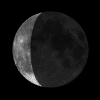Courtesy of EarthSky
A Clear Voice for Science
www.EarthSky.org

 Tomorrow, on Sunday morning, May 9, the dazzling planet Jupiter sits beneath the waning crescent moon at dawn. Both the moon and Jupiter light up the constellation Pisces the Fishes.
Tomorrow, on Sunday morning, May 9, the dazzling planet Jupiter sits beneath the waning crescent moon at dawn. Both the moon and Jupiter light up the constellation Pisces the Fishes.
One day later, on Monday, the lunar crescent and Jupiter line up side by side, for another spectacular display at morning dawn.
Jupiter has more known moons than any other solar system planet. At the last count, there are 63 moons, though only four of them are of significant size (like Earth’s moon: 2,160 miles in diameter). Jupiter’s four major moons are called the Galilean moons, because Galileo first observed these moons in the early 1600s. The largest non-Galilean moon is potato-shaped Amalthea. Its length is only about 160 miles.
In the 1670s, the Danish astronomer Ole Romer found that the eclipses of Jupiter’s moons happened earlier than expected when Jupiter was closer to Earth, yet later than expected when Jupiter was farther away. Ole Romer correctly surmised that this must be due to the finite speed of light. In Ole Romer’s day, many people thought the speed of light was “instantaneous.” Light does travel very fast, but not infinitely fast. The speed of light is 186,000 miles per second.
When Jupiter comes closest to Earth, this planet lies about 33 light-minutes distant. At its farthest, Jupiter resides some 54 light-minutes away. At present, Jupiter looms about 45 light-minutes from Earth.
Written by Bruce McClure
Astronomy Picture of the Day from NASA/JPL
U.S. Naval Observator Astronomical Information center
The York County Astronomical Society
 Print This Post
Print This Post








